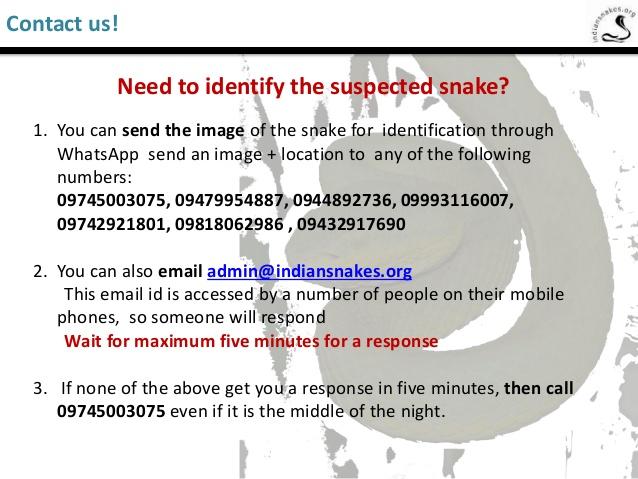Besides venom, fear and panic are the foremost reasons accounting for deaths caused by snakebites. Here's a comprehensive guide on what to do if you encounter a snakebite!
The World Health Organisation (WHO) estimates that 5.4 million people are bitten by snakes across the world every year, of which up to 2.7 million involve victims being envenomed. Of these, there are approximately 81,000 to 138,000 deaths every year. India alone makes up for around half of these.
For those of us living in urban areas and apartments, death by snakebite seems like a far off possibility. However, the results so far from the National Venomous Snakes Survey, initiated in 2017 by the Madras Crocodile Bank Trust, IndianSnakes and Premium Serums, may surprise you. According to Jose Louies, Founder of IndianSnakes, snakes do live in urban areas, and close to 70 percent of these urban dwellers are cobras. 90 percent of the snakebite deaths in India are caused by the common cobra, common krait, saw-scaled viper and the Russell’s viper – collectively known as the Big Four.
Deaths due to snake bites can be prevented providing the right precautions are taken and the appropriate first aid applied.
Prevention
There are a few simple things you can do to minimise the chances of being bitten by a snake. In fact, many of these precautions can help you avoid been bitten by other critters as well.
While outdoors: If you will be walking in forested areas, wear closed shoes (preferably sturdy hiking boots) and long trousers. Stay away from thick undergrowth as much as possible and stick to trails. Carrying a flashlight with you if you’re walking in the dark is normally a good idea. Use the flashlight even during the day if you are going to be reaching into dark spaces. Wear thick gloves or use sticks if you are going to be examining under logs, handling piles of wood, or looking in thick vegetation for whatever reason.
While sleeping: Many snake bites occur when snakes enter dwellings and people are sleeping on the floor. Sleeping on raised beds can reduce the chances of being bitten at night. Make sure you check your clothing in the morning and dust off your shoes before putting them on in the morning.
Possibly the most important rule of all is if you see a snake – do not disturb it! Snakes have poor eyesight and often rely on the movements of their prey to judge where to strike. Back away slowly if you see one without making any sudden moves. Do not attempt to imitate rescuers!

If unsure, it’s always a good idea to let professionals step in! (Image courtesy IndianSnakes. Used with permission from Jose Louies).
Signs and symptoms of Snake Bites:
Puncture marks or wounds may not always be clearly visible. Signs of envenomation can vary, but some commonly seen signs and symptoms include:
- Bleeding gums
- Blood in urine or dark brown urine
- Blurred vision or double vision
- Difficulty speaking
- Difficulty swallowing or eating
- Dizziness
- Drooping eyelids
- Nausea and vomiting
- Puncture marks or bleeding in the area where the person was bitten
- Stomach ache
- Swelling around the bite site
What to do in case of a Snake Bite:
If someone around you is bitten by a snake, you can increase the chances of their survival by carrying out a few life-saving first aid measures.
The victim: A natural reaction when something traumatic occurs is to panic. Try to keep the victim calm and reassure them you are going to get them some help. Do not give them any stimulants, including tea, coffee or alcohol. Stick to water. Keeping the victim calm will increase their chances of survival.
The wound: If there is any dirt around the wound, rinse it gently with water without touching it. However, do not attempt to use a disinfectant or apply any cream to the wound. Any form of a massage can encourage the venom to travel further in the body.
Tourniquet or not to? A tourniquet is not a good idea, as you are not trying to cut off the blood circulation to the area. However, use a pressure bandage to immobilise the limb and slow blood circulation. Start wrapping the bandage as you would a sprained ankle from the bite site upwards. If you do not have a pressure bandage handy, use a clean cloth instead – a scarf about 4 inches wide and about a metre in length will do.
Remove any rings, bangles or tight items of clothing from the limb that was bitten. They may act as a tourniquet in case of swelling.
Patient position: Keep the victim as still as possible. Position the victim so that the bitten limb or area is beneath the level of their heart. Get the patient to a hospital that stocks anti-venom immediately.
A few DON’Ts: Do not try to suck the poison out of a wound. Contrary to popular myth, cutting the wound open and attempting to drain the blood from the area will not help. There are no proven traditional remedies that work, so avoid faith healers and quacks at all costs.
Remember, a trained doctor need not see the snake to treat the patient, making a search for the snake a futile exercise. All it can serve to do is delay getting the victim the medical help he or she needs.
In case you do have a picture of the snake, get it identified by an expert.
Sources:
Louies, J., Snake Bite! - Firstaid, Facts & Prevention, 2015, https://www.slideshare.net/JoseLouies/snake-bite-firstaid-facts-prevention